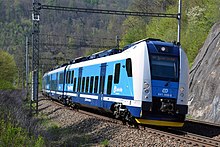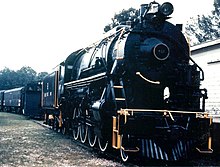Train
| Train | |
|---|---|
 Passenger train powered by overhead electricity in the Czech Republic |
A rail train, otherwise referred to as simply a train, is a set of railway[a] cars (also called vehicles) that are tied together with or without a locomotive.[b][1] Trains are used to carry people, and also things like raw material, finished goods, cargo, and waste. The vehicles that carry freight are called cars (in the United States) or wagons (in the United Kingdom). The ones that carry passengers are often called coaches or carriages. A place where a train stops to let people get on and off is called a train station or railway station.
Trains have their roots in wagonways, which used railway tracks and were powered by horses or pulled by cables. Following the invention of the steam locomotive in the United Kingdom in 1804, trains rapidly spread around the world, allowing freight and passengers to move over land faster and cheaper than ever possible before. Rapid transit and trams were first built in the late 19th century to transport large numbers of people in and around cities. Beginning in the 1920s, and accelerating following World War II, diesel and electric locomotives replaced steam as the means of motive power. Following the development of cars, trucks, and extensive networks of highways which offered greater mobility, as well as faster airplanes, trains declined in importance and market share, and many rail lines were abandoned. The spread of buses led to the closure of many rapid transit and tram systems during this time as well.
History[change | change source]

Before steam trains there were wagonways where horses and people pulled cars over tracks made of stone and wood.[2]
A steam train made its first journey on 21 February 1804 at the Penydarren Iron Works in Merthyr Tydfil, Wales, UK.[3][4] The locomotive Coalbrookdale was built by Richard Trevithick helped by the owner of the ironworks Samual Homfray.[4]
The Stockton and Darlington Railway in 1825 showed how a train could be run.[5] The Liverpool and Manchester Railway in 1830 was the first to run passenger trains and freight trains in the way that trains run on most railways today.[6] The use of trains were then to go from country to country over the world, and it was more easy for people and things to get from one place to another place.[5]
Soon after 1830 nearly all trains were pulled by steam locomotives. The steam engine was be the main way to run trains until the 1960s when many countries stopped using them, for example the United States of America had 38,853 steam engines in 1945 but by 1961 that was only 110.[7]
As the internal combustion engine that used petroleum oil and diesel oil got better people tried to use those those, but they were not very successful at first.[8] The year 1913 in Sweden was when the first successful in the world ran, and it was able to keep going until 1939.[9] The 1920s saw diesel trains get better and by the 1930s diesel trains were going very fast, including the a German train going from Berlin to Hamburg at over 100 mph (160 km/h) and a train going from Denver to Chicago, 1,015 miles (1,633 km) without stopping at an end-to-end speed of 77 miles per hour (124 km/h).[10]
While the first small railway run by electricity was in 1835 it was about after the 1890s when more electric railways and trains started across the world.[11]
After World War 1 there improvements in road cars and buses and people began to use them more than trains.[12] The same was true for how things were moved.[12] From the 1950s the aeroplane became a better way for people to go to some places that were further away.[12] Trains and railways had to get better to stop losing people and things to cars and aeroplanes but many have had to close.[12]
Types of train[change | change source]
Freight[change | change source]

Freight trains have freight cars (US) or goods' wagons (UK) to carry goods from one place to another. Some are boxcars (closed and roofed cars for cargo); others are special so they can carry special cargo. There are hopper cars for sand, coal, ore and other granulous (sand-like) materials, flatbed cars for vehicles and machinery, tank cars for liquids, container cars for containers and even bottle cars for molten iron. Almost anything which is not too large to fit under tunnels and bridges can be transported on special freight cars.[source?]
Passenger[change | change source]
Passenger trains have passenger cars (US) or coaches (UK), made so people can ride them from one train station to another. Passenger trains are usually a very comfortable way of traveling. Many trains have electrical outlets and Wi-Fi hotspots for computers and mobile devices.
Most passenger cars are single-deckers: there are also double-decker passenger cars,[13] such as the Finnish Inter-City cars.

The world's longest passenger train was 1.9 kilometres (1.2 mi) long and had 100 cars. It was a special train that ran in October 2022 in Switzerland.[14]
Trains in the city[change | change source]

To get to a city and to move around it trains may need to carry many people and they can get very busy. There are many names for this type of train including rapid transit.[15] The railway for these trains may go underground or be above the road.[15] Trains which go along city roads are called Trams.[16] A new word for trams that also use tracks used by other trains outside the city is '''tram-trains'''.[17]
Trains that go far[change | change source]
There are few long-distance passenger trains in the United States, but more in Europe and Asia.[source?]
They may have a special car where you can eat. Sometimes there are also sleeping cars (passenger cars with beds) for long overnight voyages.
Very fast trains[change | change source]
High-speed rail uses special, fast passenger trains on special tracks.[18] A few of the fast ones are maglev trains, using magnets to hover slightly off the tracks to have less friction.[19]
Crew[change | change source]
- The driver or engineer makes sure the train works right, and speeds it up or slows it down. Usually a train needs a driver to make it run well, but a few are run by computer.[source?]
- The guard or conductor makes sure the train goes the right way and tells the driver if he makes a mistake.[source?]
- Only steam trains have a fireman. He makes sure the fire that powers the steam locomotive is burning properly by putting coal into the fire.[source?]
Propulsion[change | change source]



Most trains are pulled by locomotives.[source?] Before 1900, almost all were steam locomotives. As this kind of steam engine uses very much fuel for the work it does,[source?] steam began to give way to diesel locomotives and electric locomotives during the 1930s.[source?] Today, most locomotives are diesel-electric locomotives.[source?]
Sometimes a train has no separate locomotive, but the prime mover (diesel engine or electric motor) is located on the first car of the train itself, and the car has engineer's cabin. The car is called a "motor unit". Some trains have motors in many or all of the cars. This is called a diesel multiple unit or electric multiple unit. Usually, both ends of the train have engineer's cabins. These trains are especially popular in commuter traffic in large towns and cities. Electric trains get their power from a third rail or from overhead wires.[source?]
The fastest train in the world is a special type of train using maglev propulsion, and it can reach 600 kilometres per hour (370 mph).[20]
Notes[change | change source]
- ↑ A railway is often call a railroad and is a path (track) with usually two steel rails with one or two meters between them. Other types of track are possible, for example a monorail that one single track only.
- ↑ A locomotive (sometimes called a prime mover or an engine) is a special vehicle that can move itself or other vehicles but does not carry things or people other than the people needed to drive it.
References[change | change source]
- ↑ "Definition of train (1a)". www.merriam-webster.com. Retrieved 2022-10-27.
a connected line of railroad cars with or without a locomotive
- ↑ Peter Herring (2000). Ultimate Train. London: Dorling Kindersley. p. 8. ISBN 0-7894-4610-3. OCLC 1036892037. OL 8155464M. Wikidata Q114992388.
- ↑ "BBC - A History of the World - Object : Replica of Trevithick's steam locomotive". www.bbc.co.uk. Retrieved 2022-03-18.
- ↑ 4.0 4.1 O. S. Nock (1975). Locomotion: a world survery of railway traction. London: Routledge. pp. 4–7. ISBN 0-7100-8222-3. OCLC 1858758. OL 5253681M. Wikidata Q114260807.
- ↑ 5.0 5.1 David Ross (2003). The encyclopedia of trains and locomotives: the comprehensive guide to over 900 steam, diesel, and electric locomotives from 1825 to the present day. p. 6. ISBN 1-57145-971-5. OCLC 1285577165. OL 3690962M. Wikidata Q115184543.
- ↑ John Marshall (1975). The Guinness Book of Rail Facts and Feats (2nd ed.). London: Guinness Superlatives. p. 14. ISBN 0-9004-2433-8. OCLC 2007088. OL 4946651M. Wikidata Q114966495.
- ↑ Marshall (1975). pp. 149, 152
- ↑ Colm Flanagan (2003). Diesel Dawn: Ireland's contribution to the Development of the DMU 1931-1967. Newtownards: Colourpoint Books. p. 7. ISBN 978-1-904242-08-6. OCLC 56539422. OL 3374749M. Wikidata Q115119562.
- ↑ Marshall (1975). p. 150
- ↑ Marshall (1975). pp. 150–152
- ↑ Marshall (1975). pp. 155–161
- ↑ 12.0 12.1 12.2 12.3 Ross (2003). p. 7
- ↑ David West (2015). Trains. pp. 16–17. ISBN 978-1-62588-099-4. OCLC 1195034600. OL 28682825M. Wikidata Q114970195.
- ↑ "World's longest passenger train rolls through Alps". BBC News. Retrieved 2022-11-01.
- ↑ 15.0 15.1 West (2015) pp. 14-15
- ↑ West (2015) pp. 18-19
- ↑ Nast, Condé (2019-11-24). "The UK is on the verge of a radical tram-train revolution". Wired UK. ISSN 1357-0978. Retrieved 2022-11-09.
- ↑ West (2015) pp. 11-12
- ↑ West (2015) p. 22-23
- ↑ Jones, Ben (10 December 2021). "Flying without wings: The World's fastest trains". CNN. Archived from the original on 22 October 2022. Retrieved 22 October 2022.
Other websites[change | change source]
- Train (transport) - Citizendium
